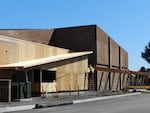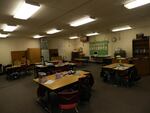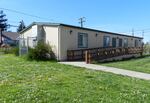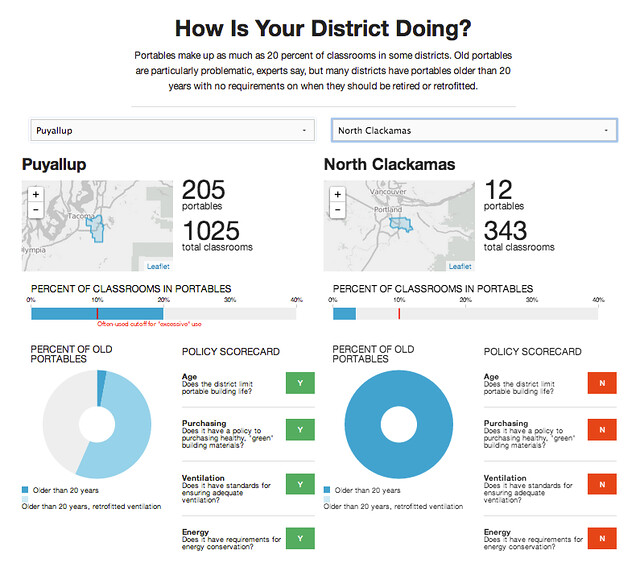
Workers at Blazer Industries push a half-built portable classroom out the door of the modular building manufacturing plant in Aumsville, Oregon.
Cassandra Profita
AUMSVILLE, Ore. – After affixing the roof to the walls, five workers push a half-built classroom out the door of the Blazer Industries manufacturing plant. Clearly, this is a portable classroom.
It’s one of about 130 portables Blazer has been contracted to build this year. Most will go to overcrowded schools in Washington state, and most will be built in four to seven days. Inside this warehouse, the company has built entire schools, churches, hospitals and high-end homes — one truckable piece at a time.
Blazer’s customers can choose what kind of buildings they want. They can order upgraded heating and ventilation systems and non-toxic building materials to improve the indoor air quality and reduce health risks, company engineer Rock Shetler said. But those options cost a lot more.
“The biggest thing with classrooms is really the budget of the school districts," he said. "When the budget only allows the cheapest materials and the cheapest products, that’s really what it comes down to.”
The state of Washington says the cheapest materials aren't good enough for new schools. It requires new school buildings to meet a long list of environmental conditions to qualify for state construction funds under the Sustainable School Protocol.
"Merely complying with minimum codes during design and installation will not ensure good indoor air quality," the state says in the protocol.
Blazer worker fills a classroom roof with insulation.
But those rules don’t apply to portable classrooms. For portables, Washington offers recommendations, not requirements.
That’s how it goes with portable classrooms in the Pacific Northwest. There aren’t any state rules for how many portables school districts can use, or how long they can use them. And there aren’t any state requirements that push districts to pay for portable classrooms that have better ventilation or safer building materials.
Jeremy Sigmon, a policy director for the U.S. Green Building Council, said the environmental health of portable classrooms is largely overlooked by regulators nationwide.
"There is very little out there that specifically calls out portable classrooms as something that ought to be regulated in any different kind of way," he said.
There aren't many rules that apply when teachers complain that their portable classrooms are making them sick. Both Oregon and Washington have failed to act on proposals to tighten indoor air quality regulations. The federal Environmental Protection Agency has a voluntary program that helps schools improve indoor air, but less than half of all schools participate.
Old And Plentiful
In Oregon, state officials are open about the lack of rules for the use of portable classrooms.
“Facilities are handled locally by local school districts,” said Crystal Greene, communications director for the Oregon Department of Education. “I am not aware of any role the state has in terms of portables.”
The 1969 portable classroom at Montclair Elementary
Individual school districts are in charge of funding and maintaining their own school facilities. If that means adding more portable classrooms or keeping them for decades, that’s a district decision.
In Beaverton, Oregon, nearly 40 percent of the school district's 209 portable classrooms are more than 20 years old. The oldest of the bunch was built in 1969.
It's a one-room unit that houses a fourth-grade class at Montclair Elementary School. Space limitations have forced the morning kindergarten class to be held on the auditorium stage while the English as a second language class is held in a closet.
"We have limited space at Montclair," said Principal Sean Leverty, as he walked into the 45-year-old portable classroom behind his school. "This one's in pretty poor shape. ... This roof has occasion to leak. You can see the hole in the tile over there."
The small windows that run along the top of one wall don't open, Leverty said, so it's hard to air the place out. The maintenance staff props the door open at the end of the day.
"They watch for condensation buildup so we're not increasing any kind of drippage on the carpet or any type of mold," Leverty said.
No State Rules, No State Help
Many districts lack funds to build new schools.
School administrators say they don’t want to use portable classrooms but they can’t afford new, greener facilities. States don't have any rules preventing the use of portable classrooms, and they don't do anything to help districts avoid using them.
At Westview High School in Beaverton, a village of 16 portable classrooms has claimed an entire parking lot and wraps its way around two sides of the school building.
"Four of our five high schools are near or over capacity at this time," said district spokeswoman Maureen Wheeler. "At the high school level we definitely have overcrowding."
The Beaverton School District is asking voters this month to approve a $680 million bond measure — the largest school bond measure in Oregon history. It would pay for the district to build three new schools and expand numerous others to accommodate the expanding student body. Wheeler said the only way to pay for those schools — even in a district with one of the state's largest budgets — is to ask voters for help.
"The state of Oregon does not provide funding for major local construction," she said. "It’s up to local communities."
If Beaverton's bond measure passes, the district will be able to accommodate 4,000 more students and remove 60 of its portable classrooms. If it doesn’t, Vancouver’s Evergreen School District may offer a glimpse into Beaverton’s future.
A village of 16 portable classrooms at Westview High School in Beaverton.
'Portables At Almost Every School Site'
In 2008, Evergreen tried and failed to pass a $250 million bond measure that would have added capacity to accommodate explosive growth in the district. It included money for three new elementary schools, a new middle school and additional classrooms as well as the acquisition of property for future schools.
That year, state auditors flagged Evergreen for "excessive" use of portable classrooms. Citing a suggested limit in Texas called the "Texas Ten Percent Portables Guideline," auditors noted that Evergreen had more than twice the recommended number of portables. And, because portable classrooms are more expensive to maintain than regular school buildings, they said, the district could save money by reducing them.
“They said you do have a lot of portables and it would be great for you to reduce those,” said Evergreen School District spokeswoman Gail Spolar. “However, they gave us no funding and no mechanism to do that other than to say, ‘Go out and ask your taxpayers to pay for new buildings,' which we’d already done.”
So, with enrollment growing and no money to build new schools, Evergreen decided it was in no position to follow the auditors’ advice to reduce its portable classrooms. Instead, it added 113 more. More than 20 percent of all the district's classrooms are in portables.
“We have portables at almost every school site,” Spolar said. “If we wanted no more portables in the district at this moment we would need an additional six elementaries. For every three elementaries you need a new middle school and for every two middle schools you would need a new high school. So you can do the math there.”
That’s six new elementary schools, two new middle schools and one new high school that the district avoids building by using portable classrooms.
How many portable classrooms are too many?
Who Is To Blame?
Spolar said the state recommended reducing portables but there was no mandate. And that’s true across the country.
Even the auditors who raised the issue acknowledged: There’s no rule for how many portable classrooms a school should have. Meanwhile, many rules keep school districts from building new schools and force them to use portables instead.
“The school districts with a portables count above 10 percent of permanent classrooms are not necessarily at fault or careless in their handling of facilities planning,” auditors wrote. “They have in large measure used portables because such action has presented the only apparent and responsive path to housing the increased numbers of students.”
With no limit on portable use, Washington tries to discourage them through funding policies. Portables aren’t eligible for state funds, nor are they counted as existing building space when the state evaluates a district’s need for funding.
School districts say that leaves those with heavy reliance on portables at a disadvantage when it comes to getting state funding for new school buildings. It also leaves them spending more of their operational budgets to sustain old and costly portables rather than to support learning.
“There's no one villain here,” said Rachel Gutter, director of the Center For Green Schools. "We're averaging 4.5 portable classrooms per school across the U.S."
If portables are inevitable, Gutter said, she would like to see the construction industry help make them green and affordable.
"We know many portable classrooms have conditions that lead to very poor air quality," she said. "It's unacceptable to have teachers or kids learning in those environments, but we think this is a very prevalent problem across the country.”
Few Tests For Indoor Air Quality
Can manufacturers help make portables greener?
Washington education officials leave ventilation issues to the state’s Department of Health, where Nancy Bernard is one person handling what used to be two departments: Indoor Air Quality and School Environmental Health and Safety.
Washington is ahead of many other states, but enforcement for good indoor air in schools is largely nonexistent. Washington law requires local health authorities to perform periodic inspections of schools, but doesn’t require them to test indoor air.
By the state’s last tally, only eight of 35 local health jurisdictions actually did the inspections. Only a handful have the capability to test indoor air, and only one agency — Tacoma-Pierce County Health — does regular testing and tracks the data.
“With school indoor air quality issues, other than the work that Tacoma Pierce County Health has done with their inspections, nobody’s going out and looking for problems,” Bernard said.
When Bernard was hired in 2003, a major component of her work was to help overhaul Washington state’s code for school environmental health and safety. Those rules have seen only minor tweaks since the 1970s, despite major leaps in knowledge about indoor air contaminants and their impacts on teachers and students.
Bernard and the health department staff worked on the update for five years, and their many proposals included tracking schools’ indoor air quality and comparing it with their number of student absences.
In 2009, the Legislature suspended their efforts with a budget proviso that the State Board of Health could not implement new regulations on schools unless there was money to do so. The Legislature has yet to lift that restriction or provide funding. (Story continues below.)
EXPLORE the database EarthFix created with InvestigateWest to see what the portable situation is like in your school district
Click anywhere on image to start comparing school districts' portable usage.
Back in 1989, a state task force in Oregon determined that indoor air quality "poses one of the most serious environmental threats to public health" and "existing state environmental and occupational health programs do not adequately protect the public from exposure to indoor air pollution." That led to a new law allowing the Oregon Health Authority to set indoor air quality standards, and conduct field tests and health studies as funding allows.
Jen Coleman of the Oregon Environmental Council said the state hasn’t acted on that law.
“It’s dependent on funding, and that funding has not been authorized by state Legislature,” Coleman said. “I wouldn't say that the problems have disappeared, but the ability to act on them never materialized."
States are hit and miss in requiring schools to address indoor air. Fewer than half of the country’s school districts have any type of program for indoor air quality. Most of the ones that do modeled their programs after the Environmental Protection Agency’s “Tools for Schools” program, which has seen its budget slashed in recent years.
Brenda Doroski, director of the Center for Asthma in Schools at the Environmental Protection Agency, said many children remain unprotected.
“Despite the progress we’ve made, there are still about 25 million children in the other half of our nation’s schools — that’s nearly 60,000 schools — who are not yet protected by indoor air quality management programs,” Doroski said.
Is My Classroom Making Me Sick?
Teachers reported feeling sick in these portable classrooms at Portland's Scott School.
Some teachers also feel they're not protected from environmental health threats in portable classrooms. Public documents show that in 2012 teachers at Scott School in Northeast Portland reported feeling unusually sick with runny noses, eye irritation, coughing, congestion and headaches. One blamed it on mold in her portable.
“After staying away from the classroom for 3 days my chronic severe head pain and nasal congestion had almost disappeared,” teacher Karen Gwaltney wrote to the school's principal. “I now have these symptoms again. My head feels as if it’s in a vice.”
The school district found carbon dioxide levels were higher than normal in the portable, its carbon dioxide sensor was broken and the ventilation system had been turned down.
The district fixed those problems and test results came back normal. More complaints were filed by Gwaltney and a teacher in an adjoining portable. Portland Public Schools again took action and again concluded that air quality was within normal levels. The state workplace safety agency concluded the problem was the result of a "personal sensitivity" and closed the file.
No one could pinpoint a problem in the portable classrooms, but if the problem was mold, as Gwaltney suspected, workplace safety rules don't exist to deal with it, according to Oregon Occupational Safety & Health Division spokeswoman Melanie Mesaros.
“There are no specific OSHA rules about mold in workplaces,” she said. “Often mold is associated with dampness, lack of cleanliness, and inadequate ventilation. However, just being 'present' doesn’t necessarily make it a health concern.”
Written by Cassandra Profita. Reported by Profita and Tony Schick. Additional reporting by Robert McClure and Kim Drury of InvestigateWest, a Seattle-based non-profit journalism studio focused on the environment, public health and government accountability in the Pacific Northwest.
Sources for this story came to us via the Public Insight Network. You can learn more and sign up to help shape OPB news coverage at OPB.org/publicinsight.
There’s more in our series, Inside The Box:
Thursday: A Problem Ignored With few rules limiting portables and protecting school environments, problems persist.













